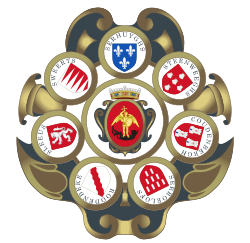| Seven Noble Houses of Brussels | |
|---|---|
 | |
| Country |
|
| Place of origin | |
| Founded | 1306 (restored) by John II |
| Traditions | Civil, military, political and economic leadership |
| Dissolution | 1794[1] |
| Cadet branches | Sleeus, Sweerts, Serhuyghs, Steenweeghs, Coudenbergh, Serroelofs, Roodenbeke |
| Website | http://www.lignagesdebruxelles.be |
The Seven Noble Houses of Brussels (also called the Seven Lineages or Seven Patrician families of Brussels; French: Sept lignages de Bruxelles; Dutch: Zeven geslachten van Brussel; Latin: Septem nobiles familiae Bruxellarum) were the seven families or clans whose descendants formed the patrician class and urban aristocracy of Brussels, Belgium.
They formed, since the Middle Ages, a social class with a monopoly, on the civil, military and economic leadership of the urban administration. This institution existed until the end of the Ancien Régime. However, as of the urban revolution of 1421, the representatives of the Guilds also exercised similar offices. Still, the offices of aldermen and captains of the urban militias were always reserved exclusively for members of the Lignages.
The long lived and rarely threatened supremacy of the Seven Houses of Brussels was based on a multitude of common interests they shared with the ducal dynasty of Brabant,[2] as well as the successive Houses of Louvain, Burgundy and Habsburg. Together with the Guilds of Brussels, they formed the freemen of the city.
- ^ The last session of the Serroelofs lineage took place on 15 June 1794: Henry-Charles van Parys, Les registres du lignage Serroelofs. Admissions et résolutions, texte établi par Monique Marchal-Verdoodt, Brussels, 2002, p. 188 : "Dernière séance : 15 juin 1794".
- ^ Arlette Smolar-Maynart, "Ducs de Brabant et Lignages bruxellois. De la stabilité d'une alliance d'affinité soutenue par l'intérêt", Les Lignages de Bruxelles, Brussels, 1995, no. 139-140, p. 199. (In French)